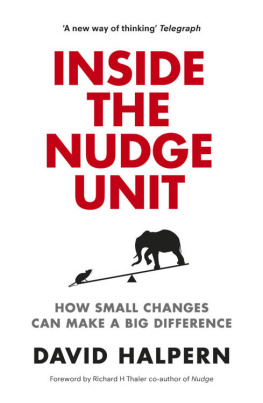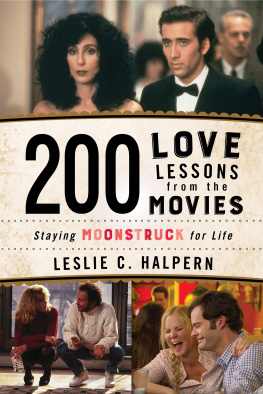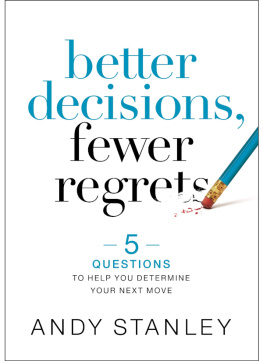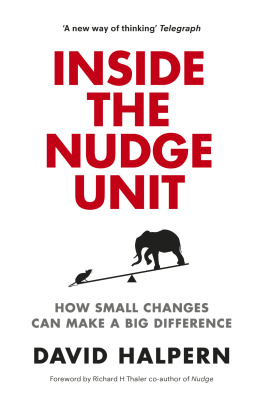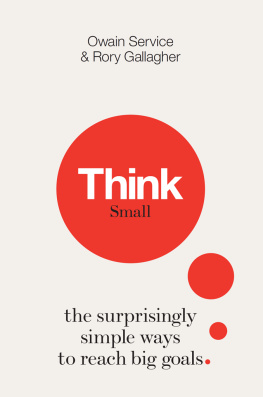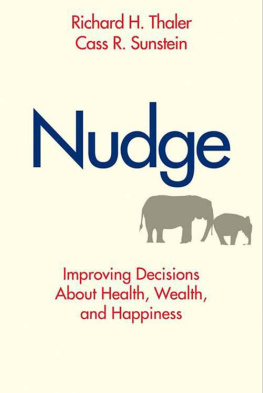Halpern - Inside the Nudge Unit: How small changes can make a big difference
Here you can read online Halpern - Inside the Nudge Unit: How small changes can make a big difference full text of the book (entire story) in english for free. Download pdf and epub, get meaning, cover and reviews about this ebook. year: 2015, publisher: Ebury Publishing, genre: Politics. Description of the work, (preface) as well as reviews are available. Best literature library LitArk.com created for fans of good reading and offers a wide selection of genres:
Romance novel
Science fiction
Adventure
Detective
Science
History
Home and family
Prose
Art
Politics
Computer
Non-fiction
Religion
Business
Children
Humor
Choose a favorite category and find really read worthwhile books. Enjoy immersion in the world of imagination, feel the emotions of the characters or learn something new for yourself, make an fascinating discovery.
Inside the Nudge Unit: How small changes can make a big difference: summary, description and annotation
We offer to read an annotation, description, summary or preface (depends on what the author of the book "Inside the Nudge Unit: How small changes can make a big difference" wrote himself). If you haven't found the necessary information about the book — write in the comments, we will try to find it.
Inside the Nudge Unit: How small changes can make a big difference — read online for free the complete book (whole text) full work
Below is the text of the book, divided by pages. System saving the place of the last page read, allows you to conveniently read the book "Inside the Nudge Unit: How small changes can make a big difference" online for free, without having to search again every time where you left off. Put a bookmark, and you can go to the page where you finished reading at any time.
Font size:
Interval:
Bookmark:
CONTENTS
This is the story of an experiment. The Behavioural Insights Team, or Nudge Unit as it came to be called, was set up in Downing Street in 2010 by Prime Minister David Cameron. The teams objectives read like a mission impossible: to transform the approach of at least two major departments; to inject a new and more realistic understanding of human behaviour across UK government; and to deliver a 10-fold return on its cost. If it failed, it was to be shut down on its two-year anniversary with enough time for voters to forget the whole embarrassing experiment before the next election.
Over its first two years, the Behavioural Insights Team (BIT) conducted dozens of experiments across healthcare, tax, energy conservation, crime reduction, employment and even economic growth. And much to everyones surprise, it worked. BITs experiments showed that seemingly small changes could have big effects and most of the interventions cost virtually nothing.
At end of two years, the results were unambiguous. Designing policy around behavioural insights led to better outcomes, easier services for the public to use, and saved money.
This is a book about the application of psychology to the challenges we face in the world today, told through the experiences of a small team in the heart of British Government.
Dr David Halpern is currently Chief Executive of the Behavioural Insights Team (BIT) and the UKs National Adviser on What Works. Prior to this, David was Chief Analyst in the Prime Ministers Strategy Unit (20012007), and has held academic positions at the Universities of Cambridge, Oxford and Harvard.

To the elected
ONE OF THE most powerful and pernicious of the many cognitive biases that have been uncovered by behavioural scientists is hindsight bias, first investigated by Baruch Fischhoff when he was a graduate student studying at the Hebrew University with Daniel Kahneman and Amos Tversky. Simply put, hindsight bias is the phenomenon that after the fact, we think we knew it all along. Would America elect an African-American as President before a woman? Sure, we all thought that could happen. Did we think in 2000 that fifteen years later most of us would be carrying powerful computers in our pockets that could keep us up-to-date with email, answer nearly any factual question just by speaking to it, and get us anywhere without getting lost? Hardly. But we take our smart phones for granted now.
By a similar process, it is easy to become blas about the story David Halpern tells in this remarkable book. For example, in 2004, just eleven years ago, I organised a session at the American Economics Association annual meeting that had the cheeky title: Memos to the Council of Behavioral Economic Advisers. None of the participants, including me, ever thought we would see the day that any government institution vaguely resembling such an entity would exist.
Nothing about this forecast changed when Cass Sunstein and I published our book Nudge, in 2008. The idea of the book was that it might be possible to use the findings of the behavioural and social sciences to help people achieve their goals, and to improve the effectiveness and efficiency of government policies, without requiring anyone to do anything. We called our philosophy libertarian (or liberal in the UK) paternalism. Perhaps because of the presence of that phrase, commercial publishers shunned the book so we went with an academic press and hoped that a few of our colleagues might read it and continue to push the intellectual agenda. Never in our wildest dreams did we consider the possibility that just seven years later, countries all over the world would be creating new government departments to incorporate behavioural science principles into the design of policies. How did this happen?
The behavioural policy agenda got a jumpstart when one of Casss former colleagues at the University of Chicago Law School got himself elected president of the United States, and appointed Cass to be the Administrator of the White House Office of Information and Regulatory Affairs. This position was created by President Ronald Reagan and its primary function is to assure that government regulations do more good than harm. During his tenure, Cass was able to use his knowledge of social science, and of nudging, to require many agencies issuing new regulations to incorporate the tools of behavioural science into the design of their policies. In fact, the Obama administration used those tools in a wide range of areas, from health care and financial reform, to healthy eating and energy efficiency. In some cases, binding documents issued by both President Obama and the Office of Information and Regulatory Affairs made sure that behavioural insights were hardwired into the work of numerous government agencies.
The next big breakthrough came when the coalition government of the United Kingdom led by David Cameron announced their intention to create a small team tasked with the job of improving the workings of government using behavioural and social science research.
Having met some of Camerons team a year earlier, I was asked to come to London for a few days and help get things started. It was on this trip that I first met David Halpern who was then being wooed to take on the job of leading the new team. David and I joined two of Camerons senior advisers Steve Hilton and Rohan Silva (I use the scare quotes because Rohan was not yet thirty) on a one-day trip to Paris to compare notes with some folks in the Sarkozy government who were contemplating a similar endeavour. Nothing came of the French effort aside from an excellent lunch, but we made good use of our time together on the Eurostar to think about what the team might do and other important matters, including deciding what it should be called. We eventually settled on the Behavioural Insights Team, though Rohan prophetically predicted that the formal name of the team would be irrelevant since everyone would just call it the Nudge Unit.
Now, five years later, it is hard to imagine what would have become of the effort had Rohan not convinced David Halpern to come back from the comfortable, good life working at the UKs Institute for Government and as an academic at Cambridge, to resume a full-time role in government. David had a unique background that made him the ideal person to lead this new effort. Not only was he a first-rate academic psychologist with a thorough understanding of modern behavioural science research, but crucially he had also worked in the Strategy Unit at 10 Downing Street in Tony Blairs administration, so knew the workings of Whitehall intimately. He had even written a report urging the application of behavioural science to public policy. I am quite sure there was no one else in the UK better suited to take on this job that was still to be defined.
David quickly formed a small team with a mix of complementary skills. No member of that team was more important than Owain Service, who quickly emerged as the de facto chief operating officer. (Hint: if you put an academic in charge of something, make sure there is someone on the team who is in charge of making sure things run smoothly.) Through some combination of creating a healthy work environment, good judgment in selecting candidates, and a bit of luck, many other early members of the team are still in place and are now serving in leadership roles.
But even once David was convinced to lead it, and his initial team was formed, few people expected the BIT to be a success. Indeed, on both sides of the Atlantic, the media were pretty sure the nudge agenda was destined to fail. In America the harshest criticism came from the political right, who viewed nudging as some kind of pernicious form of meddling. One particularly nutty talk show host kept referring to Cass as the most dangerous man in America. In Britain the press were of two minds. One was that the idea was just plain silly. References to the famous Monty Python routine using the phrase nudge nudge, wink wink were a common source of put downs. Another came from the most famous example from our book an image of a housefly etched near the drain in the urinals at Amsterdams Schipol airport which reportedly reduced spillage by 80 percent this was considered to be as good as it would get when it came to nudging. The other main criticism came from the political left, who worried that the Tories would use nudging as an excuse for avoiding tougher, presumably more effective policies. Fortunately, neither of these criticisms turned out to be well-founded.
Next pageFont size:
Interval:
Bookmark:
Similar books «Inside the Nudge Unit: How small changes can make a big difference»
Look at similar books to Inside the Nudge Unit: How small changes can make a big difference. We have selected literature similar in name and meaning in the hope of providing readers with more options to find new, interesting, not yet read works.
Discussion, reviews of the book Inside the Nudge Unit: How small changes can make a big difference and just readers' own opinions. Leave your comments, write what you think about the work, its meaning or the main characters. Specify what exactly you liked and what you didn't like, and why you think so.

